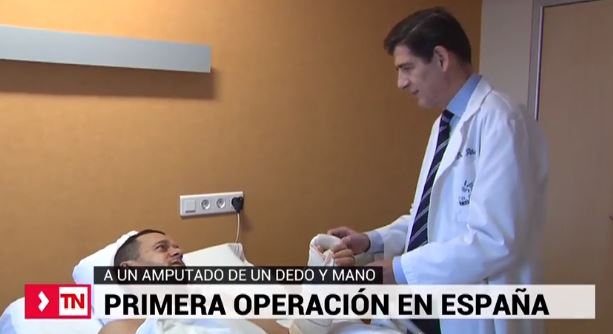Ci-dessous vous pouvez lire une traduction de traducteur humain en anglais. Vous avez également accès à l’original espagnol en cliquant sur le drapeau dans le coin supérieur droit. Ce lien vous donne accès à une version de traduction automatique de Google dans votre langue: https://goo.gl/UHrB5e
Alejandro Mayo, a merchant sailor, lost his thumb and a third of his left hand in a work accident on board of a tuna vessel in Atlantic waters. Upon his return, Mayo came into contact with Dr Piñal and his surgical team, which facilitated the development of a pioneering microsurgery procedure in Spain. (following video with english subtitles)
The Spanish surgeon performed an anatomical reconstruction by microsurgery of the area that suffered the amputation while the patient, chief engineer, performed various tasks on the ship’s systems. The process was based on a toe-to-hand transfer, although the peculiarities of the case -with the loss of the trapezium area of the left upper extremity- caused a relatively usual technique to become a pioneering surgical approach in Spain; which have been echoed by various media such as Telemadrid, TVE or the health area of Agencia EFE.

In a first step of the intervention, a transfer of the upper part of the left toe of Mayo and a bony segment with part of the joint of his second finger was made. Thanks to both, transplanted with their respective vascular and nervous systems, Dr. Piñal executed the microsurgical recreation of the mutilated area, which included the use of a vascularized flap as a covering tissue.
The design of the procedure eluded the most common technique in these cases, the ‘thumbing’ (pollicization) of the index, which involves trying to replace the thumb with that finger. Anatomical and osteomuscular structure differences mean that, in a case such as the one addressed, their results are below those obtained by Dr. Piñal and his team after 12 hours in the operating room.
In turn, in the donor foot, the remaining part of the second toe was moved to the position of the big toe or hallux, in which the unused fragments of both were combined, in order to guarantee correct stability and normal functionality.
Once the recovery of mobility in the intervened area has begun, Dr. Piñal estimates that the patient will have sensitivity again within a period of 5 to 6 months.

 es
es en
en fr
fr it
it ru
ru zh-hans
zh-hans
